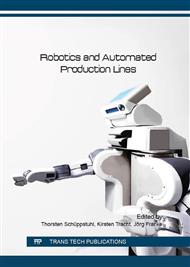[1]
C. Schwienbacher, T. Kötter and T. Schüppstuhl, Repair of Aircraft Combustors with Industrial Robots, Proc. of ISR/Robotik, München, (2014).
Google Scholar
[2]
T. Domaschke, T. Schüppstuhl and M. -A. Otto, Robot Guided White Light Interferometry for Crack Inspection on Airplane Engine Components, Proc. of ISR/Robotik, München, (2014).
Google Scholar
[3]
Leibniz Universität Hannover, Collaborative Research Centre 871: Regeneration of Complex Capital Goods. Information on www. sfb871. de [04. 01. 2016].
Google Scholar
[4]
Y. Li, M. Kästner and E. Reithmeier, Development of a compact low coherence interferometer based on GPGPU for fast microscopic surface measurement on turbine blades, SPIE Optical Metrology: SPIE. Munich, Germany, (2015).
DOI: 10.1117/12.2184749
Google Scholar
[5]
J. Beyerer, F. Puente León and C. Frese, Automatische Sichtprüfung, Berlin, Heidelberg, Springer, (2012).
DOI: 10.1007/978-3-662-47786-1
Google Scholar
[6]
Z. Gan and Q. Tang, Visual sensing and its applications, Hangzhou, Zhejiang University Press, (2011).
Google Scholar
[7]
R. Schwarte, G. Häusler and R. W. Malz, Three-Dimensional Imaging Techniques, in Computer vision and applications: A guide for students and practitioners, San Diego: Academic Press, 2000, p.178–208.
DOI: 10.1016/b978-012379777-3/50008-x
Google Scholar
[8]
T. Kötter, T. Domaschke, C. Schwienbacher and T. Schüppstuhl, Workcell calibration for robot based maintenance of airplane engine components, Proceedings of the 5th International Workshop on Aircraft System Technologies, Aachen: Shaker. Hamburg, (2015).
Google Scholar
[9]
M. -A. Otto, T. Domaschke and M. Hermann, Hochgenaue 3D-Schadensdetektion an rotationssymmetrischen Maschinenteilen mit robotergeführtem Weißlichtinterferometer, Automation 2013: Die Chancen der Cloud, Baden Baden, (2013).
Google Scholar
[10]
P. J. Besl and N. D. McKay, Method for registration of 3-D shapes, Robotics - DL tentative: SPIE. Boston, MA, 1992, p.586–606.
Google Scholar
[11]
M. Otto, T. Domaschke, S. Bahr and M. Schnell, Präzise Rissdetektion und -bewertung an Flugzeugturbinenlinern mittels Weißlichtinterferometrie, Automation 2014: Smart X – Powered by Automation, Düsseldorf: VDI-Verl. Baden-Baden, (2014).
Google Scholar
[12]
J. Canny, A Computational Approach to Edge Detection, IEEE Transactions on Pattern Analysis and Machine Intelligence, no. 6, p.679–698, (1986).
DOI: 10.1109/tpami.1986.4767851
Google Scholar
[13]
Z. Guo and R. W. Hall, Parallel thinning with two-subiteration algorithms, Commun. ACM, vol. 32, no. 3, p.359–373, (1989).
DOI: 10.1145/62065.62074
Google Scholar
[14]
H. A. Richard and M. Sander, Ermüdungsrisse: Erkennen, sicher beurteilen, vermeiden, 1st ed, Wiesbaden, Vieweg + Teubner, (2009).
DOI: 10.1007/978-3-8348-9232-4
Google Scholar
[15]
E. Roos, Anwendungsorientierte Meß- und Berechnungsverfahren zur Kalibrierung off-line programmierter Roboterapplikationen, Düsseldorf, VDI, (1998).
Google Scholar
[16]
C. Schwienbacher, F. Meiners, T. Kötter and T. Schüppstuhl, Improvement of Multi-directional Positioning Path Accuracy of Industrial Robots with Rotary Tables, Proceedings of the International Conference on Mechanical Engineering and Automation Science, Hong Kong, (2015).
DOI: 10.4028/www.scientific.net/amm.826.134
Google Scholar


